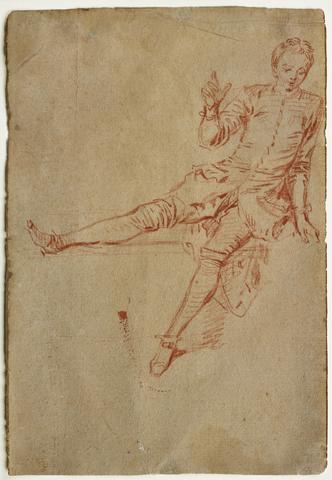
Jeune homme assis, la jambe droite et la main droite levées
Antoine Watteau (1684 Valenciennes - 1721 Nogent-sur-Marne)
1710 (vers)
Sanguine, traits d’encadrement à la plume et encre brune ; 16 x 10,9 cm
Provenance :
Paris, collection Me Wateau (?) ; Rouen, collection André Lesouëf (en 1957) ; Paris, galerie Cailleux ; Paris, collection Claus Virch ; Londres, galerie Day & Faber Ltd. (en 2012) ; Berlin, collection Bernd Schultz ; Berlin, Grisebach, 25 octobre 2018.
Bibliographie :
Karl Theodore Parker, Jacques Mathey, Antoine Watteau : catalogue complet de son œuvre dessiné, vol.I, Paris, F. de Nobele, 1957, n°10 (reproduit) ; Martin Eidelberg, « The Jullienne Spring Antoine Watteau », dans Apollo, août 1986, pp. 99, 103 ; Margaret M. Grasselli, The Drawings of Antoine Watteau, Stylistic Development and Problems of Chronology, Ph.D. diss., Harvard University, 1987, n°41 (reproduit) ; Louis-Antoine Prat, Pierre Rosenberg, Antoine Watteau, Catalogue raisonné des dessins, vol.I, Milan, Gallimard-Electa, 1996, fig. 63 (reproduit) ; Louis-Antoine Prat, Le dessin français au XVIIIe siècle, Paris, Louvre éditions, 2017, fig. 35 (reproduit).
Gersaint, qui fut le marchand de Watteau, avouait « donner une préférence à ses dessins sur ses tableaux. Watteau pensait de même à son égard. Il était plus content de ses dessins que de ses tableaux (...). Il trouvait plus d’agrément à dessiner qu’à peindre » (catalogue de la vente Angran de Fonspertuis, Paris, 1747). Louange amère autant que généreuse, venant d’un marchand, puisque ces dessins n’étaient pas à vendre, et c’est ici Caylus, l’ami et le biographe de Watteau, qu’il faut citer : « Sa coutume était de dessiner ses études dans un livre relié, de façon qu’il en avait toujours un grand nombre sous sa main (...). Quand il prenait en gré de faire un tableau, il avait recours à son recueil. Il y choisissait les figures qui lui convenaient le mieux. » (Vie d’Antoine Watteau, conférence à l’Académie royale de peinture et sculpture, 1748).
Watteau est mort à trente-sept ans, travaillait lentement ses peintures, et réutilisait régulièrement ses dessins. Ceux-ci sont donc relativement peu nombreux (669 au catalogue de référence, celui de Louis-Antoine Prat et Pierre Rosenberg). En revanche les dater exactement est difficile. On retrouve par exemple cette figure, plus gauche et costumée différemment, dans une œuvre de jeunesse, Le Printemps des Saisons Jullienne (Paris, Hôtel Drouot, 23 novembre 2012, n°97) ; mais également, inversée, modifiée, dans le personnage masqué de Voulez-vous triompher des belles (Londres, Wallace Collection), une œuvre de maturité.
Ce dessin, écrit Louis-Antoine Prat, est « aussi rapide que subtil ». On peut y ajouter, comme une caractéristique générale des dessins de Watteau, l’élégance. Nulle application, nulle hésitation, nulle imperfection, de la tête aux pieds en passant par le costume.
Cette qualité discrète mais évidente se retrouve dans les propriétaires du dessin réapparu en 1957, dans le premier catalogue raisonné : André Lesouëf, industriel normand du coton, typique de ces générations disparues d’entrepreneurs collectionneurs ; Claus Virch, conservateur en chef des peintures européennes au Metropolitan Museum puis, après 1970, marchand et collectionneur ; enfin Bernd Schultz, fondateur de la maison de ventes berlinoise Grisebach.
